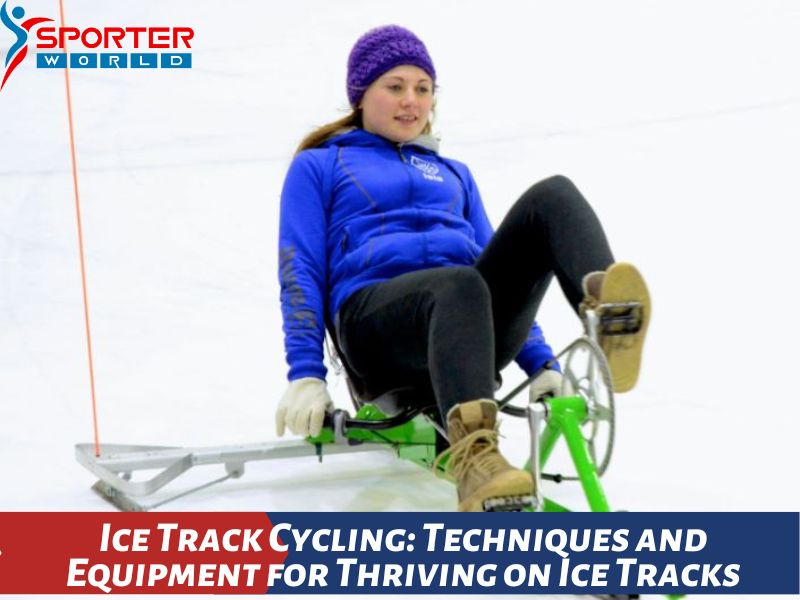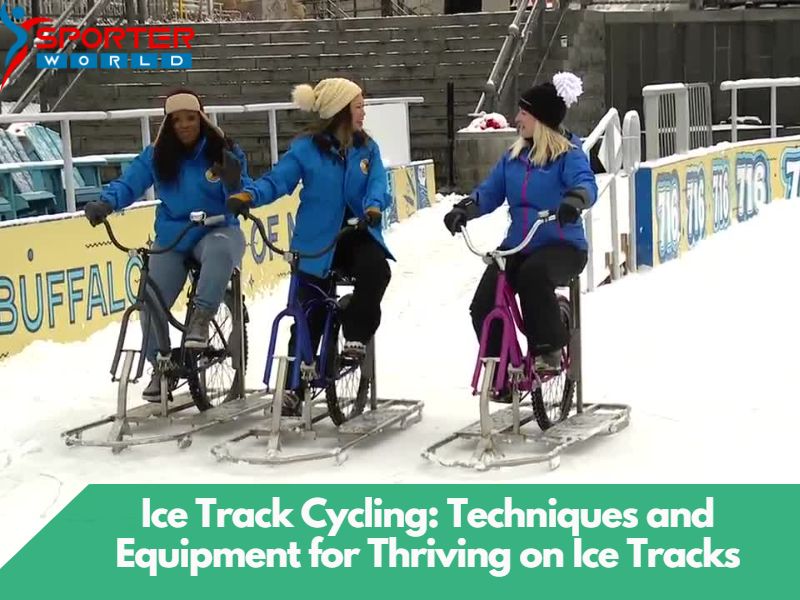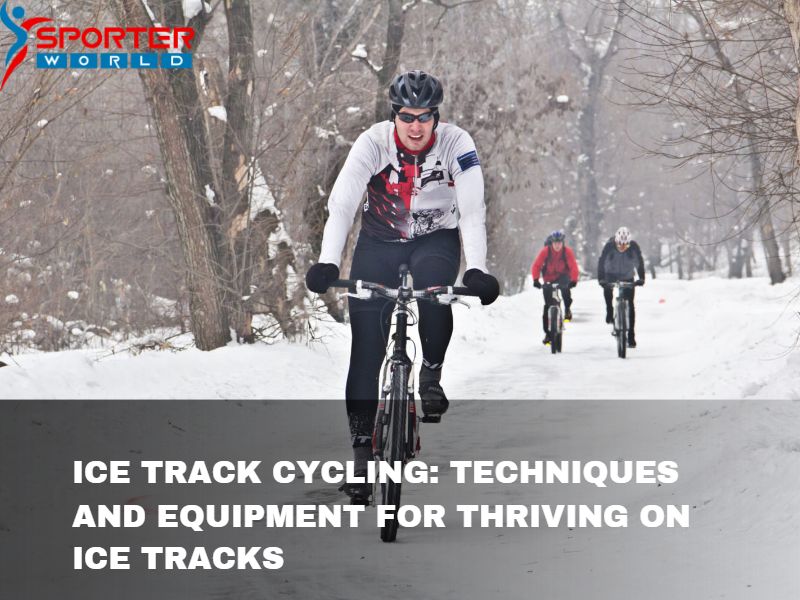Have you ever heard of ice track cycling? It may sound like a niche sport, but it is gaining popularity among thrill-seekers and cycling enthusiasts alike. Combining the adrenaline rush of cycling with the slippery challenge of ice, this unique and exhilarating sport is not for the faint of heart.
While traditional cycling is a popular and well-known sport, ice track cycling takes the excitement to a whole new level. Originating in countries with harsh winters, such as Canada and the Netherlands, this extreme sport has now found its way to various ice rinks and frozen lakes around the world.
Ice track cycling offers a one-of-a-kind experience for both athletes and spectators. The combination of speed, skill, and balance required makes it a thrilling spectacle to witness. In this article, we will delve into the fascinating world of ice track cycling, uncovering the challenges, techniques, and equipment involved, as well as the growing community that is falling in love with this icy adrenaline rush. So buckle up and get ready to explore the exhilarating world of ice track cycling.
What Equipment Do You Need For Ice Track Cycling?
To engage in ice track cycling, also known as ice track racing or ice velodrome cycling, you will need specific equipment to ensure your safety and optimize your performance. Here are the key pieces of equipment required for ice track cycling:
- Ice Track Bike: The most crucial equipment is an ice track bike specially designed for racing on ice. These bikes typically feature a lightweight frame, studded tires for enhanced grip on the ice surface, and specific gearing suitable for high-speed racing.
- Helmet: A certified cycling helmet is essential to protect your head during races. Look for a helmet that fits snugly and meets safety standards to ensure maximum protection.
- Cycling Shoes: Invest in cycling shoes with stiff soles that provide efficient power transfer to the pedals. Ice track cycling shoes often have special attachments for fitting ice spikes or screws for better traction on the ice.
- Gloves: Insulated and water-resistant gloves are necessary to keep your hands warm and maintain a good grip on the handlebars, especially in cold conditions. Look for gloves that provide dexterity while offering insulation.
- Clothing: Wear appropriate cycling clothing suitable for the prevailing weather conditions. Layering is key, allowing you to adjust your clothing based on your comfort level. Look for thermal base layers, wind-resistant outer shells, and moisture-wicking fabrics to stay dry and warm during the race.
- Eye Protection: It is recommended to wear sports sunglasses or clear goggles to protect your eyes from wind, ice particles, and glare from the ice surface.
- Knee and Elbow Pads: Considering the high-speed nature of ice track cycling and the potential for falls, knee, and elbow pads can provide an extra layer of protection and reduce the risk of injuries.
- Ice Spikes: Depending on the specific rules and regulations of the event or venue, you may need to attach ice spikes or screws to your cycling shoes. These spikes provide additional traction and stability on the icy surface, enabling better control and maneuverability.
It’s important to note that ice track cycling is a competitive and specialized sport, so it is advisable to consult with experienced riders or trainers to ensure you have the appropriate equipment and guidance before engaging in this thrilling activity.
What is The Best Type of Ice Track Cycling Bike?
When it comes to choosing the best type of bike for ice track cycling, there are a few factors to consider, such as the bike’s construction, features, and overall performance. Here are some of the best types of ice-track cycling bikes:
- Ice Track-Specific Bikes: These bikes are purpose-built for racing on ice tracks and are designed with specific features to enhance performance on icy surfaces. They typically have lightweight frames made of materials like carbon fiber or aluminum, which offer excellent strength-to-weight ratios.
- Fixed Gear Bikes: Fixed gear bikes, also known as fixies, are popular among ice track cyclists due to their simplicity and direct power transfer. These bikes have a single gear, meaning the pedals are always in motion when the bike is moving. They provide a direct connection between the rider’s leg power and the bike’s movement, allowing for quick acceleration and efficient control on the ice track.
- Studded Tires: The tires on an ice track cycling bike play a crucial role in providing traction and grip on the icy surface. Look for bikes with studded tires, which have metal studs embedded in the tread. These studs dig into the ice, offering better control and preventing slipping during turns or rapid acceleration.
- Aerodynamic Design: To maximize speed and efficiency, many ice track cycling bikes feature aerodynamic designs. This includes streamlined frames, aero-shaped handlebars, and components that reduce drag. These design elements help riders slice through the air more efficiently, resulting in higher speeds on the ice track.
- Customized Builds: Many experienced ice track cyclists prefer customized bike builds to suit their individual riding styles and preferences. They may choose frames, wheels, and components that offer optimal stiffness, responsiveness, and weight savings. Custom builds allow riders to fine-tune their bikes for specific ice track conditions and personal preferences.
It’s important to note that the best type of ice track cycling bike may vary depending on individual preferences, skill level, and specific ice track conditions. Riders should also consider factors such as their budget, availability of bike models, and compatibility with any racing regulations or guidelines. Consulting with experienced ice track cyclists or professionals at bike shops can provide valuable insights and help you choose the most suitable bike for your ice track cycling endeavors.
Read More: How Hydroplane Racing Works: A Beginner’s Guide

How To Play Ice Track Cycling?
Ice track cycling, also known as ice cycling or ice bike racing, is an exhilarating winter sport that combines the excitement of cycling with the challenge of icy surfaces. Here’s a guide on how to play ice track cycling:
- Equipment: To participate in ice track cycling, you’ll need specialized equipment. The key component is an ice bike, which is specifically designed for riding on icy surfaces. These bikes usually feature studded tires for enhanced grip on the ice. You’ll also need appropriate protective gear, including a helmet, knee pads, elbow pads, and gloves, to ensure your safety.
- Find an Ice Track: Look for ice tracks or frozen lakes that host ice track cycling events or provide a suitable environment for practice. These tracks are typically cleared of snow and maintained to create a smooth and safe cycling surface. Check local sporting facilities, winter sports clubs, or event organizers for information on available ice tracks.
- Learn the Basics: Before diving into ice track cycling, it’s important to have a solid foundation in traditional cycling. Familiarize yourself with basic cycling techniques, such as balancing, pedaling, and braking. Practice on regular surfaces to build your cycling skills and gain confidence before transitioning to icy tracks.
- Adapt to the Ice: Ice track cycling requires adjustments to your cycling technique due to the slippery surface. Focus on maintaining a stable and balanced position on the bike. Keep your weight centered and distribute it evenly to maximize traction. Start with slower speeds and gradually increase your pace as you become more comfortable and confident on the ice.
- Cornering and Braking: Mastering cornering and braking techniques is crucial in ice track cycling. Approach corners with caution, leaning into the turn and using your body weight to maintain balance. Use controlled and gradual braking to avoid skidding on the ice. Practice these techniques to improve your control and maneuverability on the ice track.
- Safety First: Safety should be a top priority in ice track cycling. Always wear appropriate protective gear, including a helmet, to protect yourself from potential injuries. Pay attention to the condition of the ice track, and avoid riding if the surface is too uneven or dangerous. Be aware of other cyclists on the track and follow any rules or guidelines set by the track organizers.
- Participate in Events: Once you have gained sufficient experience and confidence in ice track cycling, consider participating in organized events or races. These events provide an opportunity to showcase your skills, compete against other cyclists, and immerse yourself in the thrill of ice track cycling.
Remember, ice track cycling can be physically demanding and challenging, so it’s essential to gradually build your skills and progress at your own pace. Seek guidance from experienced ice track cyclists or consider taking lessons or training sessions to improve your technique and performance.
Enjoy the exhilaration and unique experience of ice track cycling while embracing the beauty and excitement of winter sports on the ice. Stay safe, have fun, and embrace the adventure that ice-track cycling offers.
What’s The Racing Format of Ice Track Cycling?
The most common format of ice track cycling is divided into two basic categories: timed/individual races and multiple bike races. Timed races are similar to speed skating events, where competitors race against the clock across various distances, ranging from 500m to 10,000m, with no more than two riders competing for each round.
In addition, an automated timing system that is linked to the internet is in place along the finish line, in which a transponder on each competitor will be detected by a wire loop embedded in the ice. For multiple bike races with up to 20 bikes allowed, riders begin from a start grid and will complete three, five, or nine laps depending on their event level. Furthermore, a qualifying flying lap conducted beforehand based on time will decide rider placement for the smart grid. Overall then, these two main types of race formats vary by distance and number of competitors for each event while employing different techniques for both qualifying and racing.
Read More: What is Horseball? A Guide to the Fast-Paced Game on Horseback

Frequently Asked Questions
Is ice track cycling dangerous?
Ice track cycling can be a thrilling sport, but it does come with inherent risks. The slippery surface and high speeds involved can increase the chances of accidents and falls. That’s why it’s crucial to wear proper safety gear, follow safety guidelines, and practice good technique. Taking necessary precautions and gradually building your skills can help minimize the risks and ensure a safer experience.
Do I need any special equipment for ice track cycling?
Yes, ice track cycling requires specialized equipment. The most important piece of equipment is an ice bike designed specifically for riding on icy surfaces. These bikes typically have studded tires for better grip. Additionally, you’ll need protective gear such as a helmet, knee pads, elbow pads, and gloves to protect yourself in case of falls or collisions.
Can I participate in ice track cycling as a beginner?
While ice track cycling can be challenging, beginners can certainly participate. It’s important to have a foundation in traditional cycling techniques before venturing onto the ice. Starting on regular surfaces to build your skills and confidence is recommended. You can then gradually transition to ice tracks and practice at your own pace, gaining experience and improving your abilities over time.
Are there any age restrictions for ice track cycling?
Age restrictions may vary depending on the specific event or location. Some ice track cycling events may have minimum age requirements for participants due to safety considerations. It’s advisable to check with the event organizers or local regulations to determine if there are any age restrictions in place.
Conclusion
Ice track cycling is a thrilling winter sport that can provide an unforgettable experience. It’s important to equip yourself with the right gear and gradually build your skills at your own pace. Make sure to abide by safety guidelines and take necessary precautions to ensure a safe and enjoyable experience.




